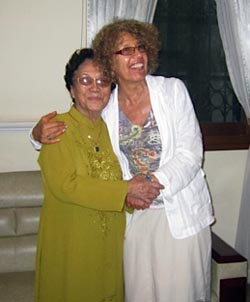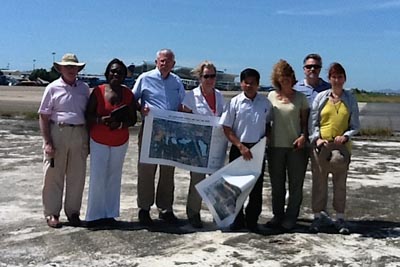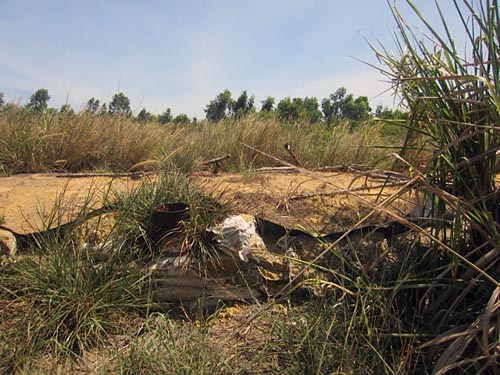 |
Revisiting Vietnam: Agent Orange/Dioxin Devastation ContinuesBy Susan SchnallWe are a group of seven scientists and public health professionals brought together by our interest in and concern about the lasting impact of the use of Agent Orange/dioxin sprayed multiple times over south and central Vietnam from 1961-1971. We have spent months, some of us years, reviewing studies and articles.
It is 9:30 pm on June 4th. We are at the end of a 24-hour plane trip, preparing for landing at Hanoi Airport. I can see the lights of the city and, even though this is my third trip back to Vietnam, I feel the nervous excitement of going to north Vietnam on a peaceful mission. In my mind's eye, I can see the news broadcasts of the horrors of battle, the men screaming from pain, filthy with mud, blood seeping through their bandages, crying while holding a buddy in their arms. And I picture the young girl running along a dirt path, naked, on fire from US napalm. Then I am back in the long, open wards of Oak Knoll Naval Hospital. It is 1967, midnight, on a unit that houses 40 young men who are groaning and mumbling to each other as they make their way through a mine field and their nightmares: "Hey, man, be careful, there's a booby trap, watch it, watch it." Reliving their fear and uncertainty as they crawl on their bellies through the jungle. Every three to four hours, when their pain medication is available, there is a chorus of voices for "nurse, nurse." My heart, my soul wants to soothe them, tell each one of them that they will be ok—these young men missing an arm, a leg, their limbs being held aloft by devices that look like butcher hooks. I know even then that their trials are only beginning, that this war will be with them the rest of their lives. In June, 2012, I am part of a delegation of science and public health professionals affiliated with the Vietnam Agent Orange Relief and Responsibility Campaign a project of VVAW and VFP, invited to Vietnam by the Vietnam Association for the Victims of Agent Orange/dioxin. The purpose of our trip is to visit people suffering from illnesses recognized among American veterans to be associated with the spraying and use of AO/dioxin by the US military during the American conflict in Vietnam. We also survey the land that continues to be contaminated by dioxin, threatening illness, pain, and suffering to thousands of Vietnamese, long after the cessation of fighting. Most striking are the severe birth defects—some of which are recognized as associated with Vietnam service among US veterans, now seen also in Vietnamese children. Members of the American delegation included: Dr. Franklin Mirer, Professor of Environmental and Occupational Health at Hunter College of the City University of New York and former Director of the Health and Safety Department for the United Automobile Workers; Dr. Jean Grassman, Associate Professor at City University of New York and researcher investigating the effect of dioxins on human populations; Dr. Michael McGarvey, whose career includes executive responsibility at the federal, state, and local levels, academic administration and teaching at New York university, and senior executive positions in the private sector; Dr. Carole Baraldi, a professional nurse practitioner and educator on disability and women's health care; Marie Elivert, a health care executive with over 35 years in the private and public sector; Dr. Daniel Robie, Assistant Professor at York College of the City University of New York where he conducts research, has authored a number of scientific papers, and teaches physical, analytical, and inorganic chemistry. Also, myself, Ms. Susan Schnall, Adjunct Assistant Professor at New York University in Health Policy and Planning, worked for 31 years as a senior executive in public hospitals in New York, and is a co coordinator of the Vietnam Agent Orange Relief and Responsibility Campaign and a national coordinator of Vietnam Veterans Against the War.
The delegation began the trip in Hanoi, meeting with VAVA and members of the Office of the Committee of 33 to discuss the history of the use of defoliants from 1961-1971 and the serious and long lasting impact on the people and land of Vietnam. Priorities of VAVA are: environmental remediation of the hot spots (where the US maintained their bases), prevention of birth defects; survey of foods that are most contaminated, education of people about safe foods, care for victims in the hot spots, research on diseases correlated with AO/dioxin exposure, provide services to women and children exposed, establish rehabilitation services and special schools as needed. After our meeting, we travel to Thi Binh and visit an occupational school whose students are dealing with birth defects caused by parental exposure to the herbicides. We meet an older man—veteran of the US conflict, who is lying on a bamboo mat, crying silently in pain, tears running down his cheeks. He is curled up, arms and legs rigid, unable to move. His wife sits next to me, speaking quietly in Vietnamese, gently taking my arm. I talk to her through an interpreter to let them know we are Americans who come to help heal the terrible wounds of war our country has inflicted. Some of us weep. But it is the children, the second and third generation babies and children born with enlarged heads and bulging eyes, or curled up on these raised bamboo mats, their bodies twisted and rigid, extremities bent so they replicate being in the uterus, tremors cursing through their limbs—and they look at you when you reach out a hand and touch them. Though they are not able to speak, they smile and react while siblings and parents stand by on dirt floors, in wooden shacks with no running water or electricity. The village people come to see the strangers. We are all struck by the devotion of the families and the care these children receive. Our visit the next day, June 7th, takes us to visit the Vietnamese Women's Sanitation Project in Hai Dong, run by the local commune with starter funds from a number of foundations, this is a micro credit project where families borrow money to improve and then pay back the funds which are then used for another family in the district. We visit A Loui and Hue, areas that were brutalized by fighting during the American War, and sprayed countless times by aircraft with the herbicides designed to destroy farmlands and forests, jungle cover and food supplies. We visit with the remnants of war—the children, disabled and contorted by those chemicals inflicted on their parents. There are, as well, official meetings with Madame Nguyen Thi Binh, the main negotiator for the Provisional Revolutionary Government at the Paris Peace Talks in the early 1970's. Today Madame Binh is head of the Vietnam Peace and Development Foundation. We talk with her about our impressions from our visit and work on behalf of those who have been harmed by the use of herbicides in Vietnam. She speaks about the suffering of the Vietnamese people and the responsibility of the chemical companies and the US government to ease the suffering. She is well aware of the unsuccessful legal suit and our efforts to pass a congressional bill—HR 2634 Relief for the Victims of Agent Orange Relief Act of 2011. She asks about our chances for success and we promise we will continue our work until there is justice for the Vietnamese. Deputy Prime Minister Nguyen Thien Nhan meets with our delegation and promises collaboration with us on the Agent Orange/dioxin struggle. He suggests that American scientists conduct additional research to establish the most appropriate methods for environmental detoxification and treatment for Agent Orange victims. DaNang, once used by the Americans as a Marine base, has become an international city with tall commercial centers, resort areas, modern architecture, bustling with activity. We visit the former air base and learn about the plans for remediation through the use of thermal desorption. The land is brown, with patches of long grass, grey concrete poured over areas to contain the remaining dioxin. There is a chemical odor and overcast present. Residential housing across a road is separated by a wire fence to keep people from fishing in the contaminated Sen Lake. Funds for the remediation of the airfield have been allocated, the contract is about to be let and then work will begin. There are 28 remaining "hotspots" in Vietnam, all of them former US military bases. Studies need to be done on those areas as well to determine continuing risk of exposure to the people who live nearby—and then the clean up will begin. Our visit to VAVA DaNang and Center 3 for Children engages all of us with music, singing and dancing. A couple of days later Dr. Nguyen Thi Ngoc Phuong greets us in Ho Ch Minh City at Tu Du Hospital where we visit the children's unit. Dr. Phuong was formerly Director of the hospital and Director of Obstetrics. During the American War she delivered many babies who were born so deformed that she couldn't show them to their mothers. In 1974 she researched a document from the National Academy of Sciences describing the problems. Dr. Phuong did a comparison study in Ho Chi Minh City which was a case comparison between mothers who were and were not exposed to the chemicals. A study with Dr. Zena Stein from Columbia University was presented at the 1987 International Dioxin Conference. Sixty children live in Tu Du Hospital, suffering from the effects of Agent Orange/dioxin. They have spina bifida, congenital limb deformities, multi-joint stiffness, microcephaly (small brains), hydrocephalus (enlarged brains), cerebral palsy, and heart defects. One of the children was born without arms and writes with her toes. Tran Thi Hoan is one of those children. She was born December 16, 1986 without two legs and a hand into a farming village in Binh Thuan province in central Vietnam. Her mother was exposed to Agent Orange when farming her land by canisters buried in the soil. Hoan was the first Vietnamese Agent Orange victim to testify before a House committee on the effects of Agent Orange. She noted: "many babies, children and young people my age live lives of quiet agony. They are trapped in bodies that do not work. Their brains remain in infancy even as their bodies grow. I am aware that the children and grandchildren of US veterans exposed to Agent Orange are suffering like us. We hope that they receive the medical care and assistance they need." And now it is up to us to educate the American public about the deleterious and lasting impact of the use of herbicides in Vietnam. We can do this by supporting the Relief for the Victims of Agent Orange Act of 2011 (HR 2634) that would provide needed services to the children of American veterans, provide care and services to the Vietnamese and Vietnamese Americans harmed by the spraying and their children, and clean up (remediate) the land in southern Vietnam that continues to be contaminated by the dioxin. Susan Schnall is a co-coordinator of the Vietnam Agent Orange Relief and Responsibility Campaign, chairing the legislative outreach and science group. She is currently a professor in Health Policy and Planning at NYU and a member of VVAW, VFP and APHA. In 1969 she was tried and convicted by a general court martial for her anti-war activities while a member of the US Navy.
|




